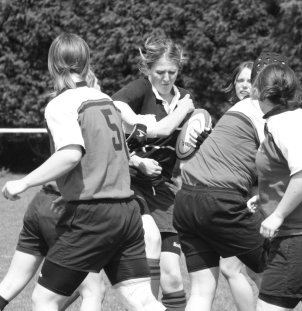
Participation among women and girls is shown to be declining
Play fair: is sport equality a myth?
Is the concept of equality in sport a real commitment or empty rhetoric? Aj Sharma and Anna Gray consider the reality from their perspective as equality trainers and consultants.

Participation among women and girls is shown to be declining
One of the exercises integral to our equality and diversity training workshops is called Attitude Squares. Participants are asked general, thought-provoking questions to determine their viewpoint along a scale of strongly agree, agree, not sure, disagree and strongly disagree. A consistently challenging question is: are the organisations that you represent committed to addressing inequalities in sport? Most people go straight to ‘agree’ with some ‘not sure’ and a few saying ‘disagree’. A supplementary question then follows: what does this commitment look like? At this point silence ensues before people respond in the following ways. “We have an equal opportunities policy.” “We have a lead officer for equality.” “We have achieved the foundation and preliminary levels of the Equality Standard: A Framework for Sport.” Further questioning reveals that this commitment is often cosmetic, organised and publicised to meet the requirements of funding bodies and is not adequately resourced.
What is it that prevents real and meaningful progress towards addressing inequalities in sport? We have identified a number of contributory factors. Organisations often write equality and equal opportunity policies by cutting and pasting information into templates, there is little meaningful consultation during development with staff and consequently there is minimal ‘buy in’ to the equality agenda. In sport, as in many sectors, there is a significant gap between policies and practice, and commitment remains within the words of the policy only. Lead officers for equality (LOEs) within organisations often have not attended any relevant training and share this role and responsibility with that of safeguarding, which often takes priority, which in turn means that LOEs spend less than one day a week, on average, fulfilling their duties and responsibilities with regards to equality. Often the LOE has “got the organisation through” the equality standard with little impact upon the rest of the organisation’s staff, especially at the foundation level. There is a distinct lack of leadership, equality and diversity is not prioritised within many organisations and in recent times this area has been under-resourced, often falling off the agenda.
There are, of course, exceptions to the picture being painted and there are indeed many examples of good and progressive practice, including the Inclusive Fitness Initiative, the Greenhouse Schools Project, Age UK’s Fit as a Fiddle programme, the Pridegames, and Sweat in the City. However, there is a systemic failure to make more than superficial changes and this is despite the fact that, in the main, sports organisations are funded through the public purse and fall under the auspices of equalities legislation. At the last count 150 national sports organisations, national governing bodies of sport and county sports partnerships had made progress along the equality standard for sport. However, since the launch of the standard in 2004 all of six years ago, less than half of the 150 have achieved the preliminary level and only four the intermediate level. Many of these organisations are due to re-submit to their existing levels as the three years shelf life of the highest level achieved has elapsed or is imminent. The picture is one of stagnation, not progress.
So what about the impact of all these policies and programmes on the end user? According to the Women’s Sports and Fitness Foundation (WSFF) – and they should know – “Over 80% of women are not active enough to stay healthy. Young women leave school half as active as young men.” The WSFF goes onto state that “women hold just 1 in 5 of the top jobs, investment in women’s sport lags far behind men’s and as little as two per cent of sports media coverage is devoted to female competitors and teams”. You only have to look at the England women’s cricket team’s achievements last year and the subsequent paucity of coverage for an example.
Recent Active People Survey results show that women’s and girls’ participation in sport and physical activity is declining and black and minority ethnic (BME) communities continue to be marginalised in accessing participation and funding opportunities (in fact, Sport England and its partners failed to meet the nation’s sports development agency’s BME community targets in the last delivery plan submitted to the Department for Culture, Media and Sport, according to an article in The Independent newspaper). Approximately half of all disabled adults are unemployed, often due to prejudice and stereotyping, and consequently have less disposable income to benefit from opportunities within the sports sector.
During the consultation phase of the development of the new Equality Act – an attempt to rationalise and harmonise the various pieces of equalities legislation developed over the last 40 years – the Equality and Human Rights Commission indicated that, at the current rate of progress, it would be another 100 years before black and minority ethnic communities received parity in the recruitment process. A mapping study conducted in 2005 (conducted by Sports Structures Ltd) showed that BME people are very much under-represented at all levels within the sports workforce, especially at senior levels. Looking at the equality profiles of many sports organisations, there is little doubt that this situation has not changed significantly. Many sports organisations are struggling to address the needs of these three main equality strands. Other strands, such as lesbian, gay, bisexual and transgender (LGBT), older people and those following a particular religion or belief, have not even been considered.
A further cause for concern is that only 15% of monies allocated to the delivery of Sport England’s community sports strategy focuses upon encouraging new participation. This means that the majority of funds are being used to retain existing participation levels, levels where members of one or more equality strands, in general, remain under-represented. How then is this a development strategy? Perhaps it should be re-named the Existing Sports Strategy, although Active People Survey results continue to indicate that participation levels in most sports is declining so Sport England and its partners are not even managing to maintain the status quo!
The comprehensive spending review (CSR) will certainly have an impact upon sports provision. Sport England’s settlement from the secretary of state for culture, Olympics, media and sport (DCMS) represents a 33% reduction in grant aid revenue by 2014/15 but the full picture is still unclear. There is certainly an impact on sport’s main equality partners the Women’s Sport and Fitness Foundation, the English Federation of Disability Sport and Sporting Equals Limited, whose role it is to support the inclusion agenda. They are due to face a 30% reduction in their core funding over four years, further limiting their ability to support and address the inequalities that still exist. These ‘partners’ receive their core funding from Sport England and are sometimes in a situation where they are reluctant to bite the hand that feeds them but bite that hand they must if Sport England, the purported lead sports development agency in the country, is really going to provide the leadership that this agenda urgently requires. Otherwise this ‘comfortability factor’ may remain in place to the great detriment of people from all communities. A more positive scenario would see the equality partners funded directly by the DCMS so that Sport England and its work would come under closer scrutiny and be challenged to produce the results that public monies demand.
Initial news, however, seems more positive elsewhere with county sports partnerships securing long-term funding and the new government’s National Lottery reforms supporting the Places People Play initiative designed to focus upon a mass participation legacy from the London 2012 Olympic and Paralympic Games. Add to these the new Olympic and Paralympic-style school sport competition and perhaps there is light at the end of that long tunnel with the 2010 Equality Act in force and the imminent Olympic and Paralympic Games providing real opportunities to refocus efforts to addressing inequalities within sport and sports.
Lord Coe has stated “We will use the power of the Games to inspire young people to take up sport” but we need to work collectively to ensure that this includes all young people regardless of background. The Games’ legacy is crucial to ensuring that all communities are engaged, enthused and involved in sport and physical activity at all levels and in all positions. Equality champions and leaders are needed, never more so than now and people like Stephen Frost, head of diversity and inclusion for the London Organising Committee of the Olympic and Paralympic Games and the Sports Councils’ equality group can influence and ensure that at the very least all Olympic and Paralympic national governing bodies of sport have achieved the intermediate level of the equality standard for sport by the time the Games are here. We need to change the culture of sport so that equality and diversity is not an afterthought or an add on and we need to do it now.
Anna Gray and Aj Sharma are senior consultants at Sport Structures Limited. Anna and Aj can be contacted at anna@sportstructures.com and aj@sportstructures.com
This article is an expanded version of one previously published in Industry Insight.
The Leisure Review, December/January 2010/11
© Copyright of all material on this site is retained by The Leisure Review or the individual contributors where stated. Contact The Leisure Review for details.
Download a pdf version of this article for printing

